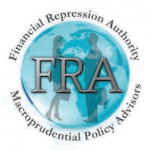
It’s Called Financial Repression, and Governments Around the World Are Doing It
Countries are adopting policies to encourage or require savings to be lent cheaply to the government

The Bank of Japan took special measures last week to help its banks access greenbacks. Above, the central bank in Tokyo last month.
SOURCE: Wall Street Journal By JAMES MACKINTOSH Aug. 1, 2016
The money markets are screaming about a global shortage of dollars. Financial stress indicators are flashing yellow. The Bank of Japan on Friday took special measures to help its banks access greenbacks, and interbank borrowing rates for dollars are at the highest level since 2009.
In the 2008 and 2011-12 panics, the money markets acted as a warning of a credit crunch, as trust between lenders and borrowers broke down. This time, though, the signs of stress are a result of something else: The campaign by governments to direct financing to themselves, limiting access by the private sector.
In the U.S., there are legal changes under way in the money markets, which is prompting money to shift from “prime” funds, which buy short-term debt issued by companies, to instead buy short-term debt issued by the U.S. Treasury.
This is merely the latest example of what academics call financial repression, a broad category of government policies adopted to encourage or require savings to be lent cheaply to the government. Repressive policies were the norm in Western markets for decades following World War II. That was until the financial liberalization was begun by Margaret Thatcher in the U.K. and then-President Ronald Reagan in the U.S.
New rules since the Lehman Brothers failure have again tightened the screws on lending to the private sector, while favoring government financing in multiple, complex ways, most obviously through exempting banks from holding capital against government debt.
There are, of course, good reasons for most of the restrictions on the financial sector, including on money funds. Don’t forget that, after Lehman, the U.S. government bailed out the money markets with a guarantee against losses.
The aim of the overhauls is to prevent a repeat of the panic selling of prime funds, akin to a bank run. The most eye-catching rule will stop institutional funds from offering an unchangeable $1 net asset value for each dollar on deposit. This is designed to reduce the psychological impact of “breaking the buck,” or falling below $1, which can lead to widespread withdrawals.

All money funds also will be given an option to restrict or impose a fee on withdrawals when a fund’s easy-to-sell assets are depleted. This makes explicit that in times of stress it might be impossible to access one’s money. This has prompted assets in prime funds to drop below $1 trillion for the first time this century.
So far, so sensible. But there is a wrinkle. Money funds that buy government paper are exempt from the new rules, on the basis that Treasury bills are always easy to sell and there is no risk of default. The rule makers seem to have forgotten the near default in 2010 and the downgrade of the U.S. debt rating, not to mention the accidental failure to pay some Treasury bills in April 1979 due to paperwork backlogs.
The effect of the exemption is that money has poured in to government funds as investors worry that they might not always be able to access cash in prime corporate funds.
Carmen Reinhart, a finance professor at Harvard University’s John F. Kennedy School of Government, says governments across the developed world are interfering more with private flows of cash as their financing needs soar. Directing money to the state at the same time as the central bank keeps interest rates below inflation to boost growth amounts to a subsidy of the government by savers, a hidden tax.
“The way we have revamped regulation has clearly favored government debt,” she said. “The regulation creates the captive audience, and the monetary easing creates the ‘tax.’ ”
Outside Iceland, Greece and Cyprus, the West remains far less financially repressed than in the 1950s or 1960s, when capital controls meant Britons couldn’t take more than £50 ($66) out of the country, while Americans were still forbidden from investing in gold.
But subtle rules funnel more bank and insurance-company savings to government paper, by assuming it is always easy to buy and sell and will never default. Accounting shifts have encouraged corporate pension plans out of volatile stocks and into bonds, and several countries have grabbed assets from state pension funds.
There is hope. Financial repression is on the rise, but savers still can avoid it. Prime money-market funds might look less attractive under the new rules, but the economic reality of what they own remains unchanged, as do the risks. Just because a fund can now suspend withdrawals or impose a fee in a crisis doesn’t mean that under the old rules money would have magically been available.
Other options remain open, too. While rates may be low everywhere, cash still can be sent abroad and pays more in some countries. Finally, anyone worried enough about financial repression to want to avoid government paper entirely can switch into gold. So long as that remains an option, financial repression isn’t complete.




 08/05/2016 - WSJ: “It’s Called Financial Repression, and Governments Around the World Are Doing It”
08/05/2016 - WSJ: “It’s Called Financial Repression, and Governments Around the World Are Doing It”


